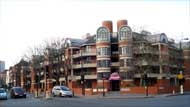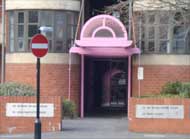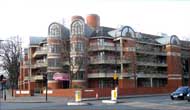Battersea General Hospital
33 Prince of Wales Drive, Battersea Park, SW11 4BQ
Medical dates:
Medical character:
1902 - 1972
General
The National Anti-Vivisection Hospital was founded in
1896 by Mrs Theodore Russell Monroe, the Honorary Secretary of
the Anti-Vivisection Society 'for the relief of human suffering by
physicians and surgeons who are opposed to vivisection'. The
Hospital did not allow medical experiments on animals to be carried out
on the premises and, indeed, did not employ any doctor who agreed to
such practices.
The years 1896 to 1901 were preoccupied with raising funds and finding
suitable premises for the Hospital. Eventually a private
residence - Lancaster Towers - was converted to a hospital in 1902,
largely financed by Lady Headley, who felt strongly about animal
welfare.
From 1903 in-patient beds were available - 11 for adults and 4 for
children. In 1906 the Hospital absorbed the Hospital of St
Francis, another anti-vivisection hospital, at Darenth House, 34
Camberwell Green, which had closed in 1904 (this had previously been at
145 New Kent Road and had closed in 1903). The Hospital of St
Francis had been founded by Dr Joseph Oldfield, who then went on to
establish the only fruitarian hospital in England, the Lady Margaret Hospital in Bromley.
In 1910 the Hospital was renamed with the ungainly title The
Anti-Vivisection Hospital, The Battersea General Hospital. The
anti-vivisection movement had much support in Battersea, and the National Anti-Vivisection Society still exists today, with its headquarters at Millbank.
However, the efficacy of the treatments offered by the Hospital did not
meet universal approval. Applications to the King Edward's
Hospital Fund for financial aid were repeatedly turned down as the
Hospital did not comply with 'those general conditions which
they consider should govern any hospital designed for the best form of
relief for the sick poor'.
In 1914, during WW1, 20 beds were given over for military patients.
In 1928 the Hospital was involved in a legal case over a disputed Will.
Constance Edith Guerrier had bequeathed her estate to 'The
Women's Hospital, Battersea'. The Borough Council argues that the
maternity home in Bolingbroke Grove was the only hospital solely for
women in Battersea. In the event, the South London Hospital for
Women received the bequest. The Anti-Vivisection Hospital, The
Battersea General Hospital contested this on the basis that half their
beds were devoted to women, with a special cancer ward, and previously
the Hospital had been staffed entirely by female doctors. They
lost the case.
By 1935 the Hospital was in severe financial difficulties and the
Governors decided that any reference to anti-vivisection should be
dropped. However, this change required the sanction of the High
Court as the Hospital was bound by trust deeds. While the legal
process was initiated, a large part of the Hospital had to be closed
because of lack of funds. At the end of the year the High Court
gave its approval for the change of ethos, making the Hospital finally
eligible for grants from the King Edward's Hospital Fund. It was
renamed simply as the Battersea General Hospital.
During WW2 it joined the Emergency Medical Scheme with 85 beds.
In 1943 Sir Peter Lindsay, Managing Director of the Morgan Crucible Company, Battersea, became Chairman of the Hospital.
In 1948 the Hospital joined the NHS, coming under the administration of
the Battersea, Putney and Tooting Group. It had 79 beds.
For Coronation Day in 1953 Mr KM Hubbard, a local radio and electrical
engineer, loaned 8 TV sets to the Hospital so that the patients could
watch the ceremony. By this time the cost per in-patient per week
was £16 16s 1d (£18.80). During this period there was
a shortage of nurse recruits, because of the reduced birth rate in 1936
and the subsequent lack of 18-year-old girls for training. This
made life difficult for all hospitals, and patients had to be turned
away when there were no acute beds available due to lack of staff.
The Hospital closed in 1972 following a reorganisation of the NHS.
|
Present status (February 2008) |
|---|

The complex, as seen from Prince of Wales Drive

The bright pink main entrance to the block

The complex, as seen from Albert Bridge Road
References